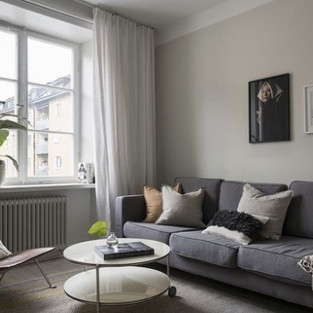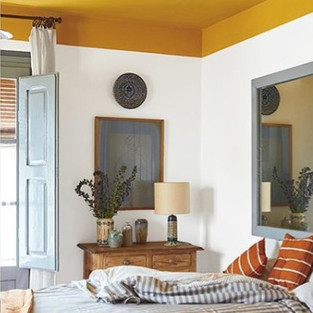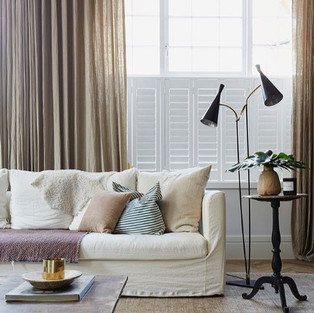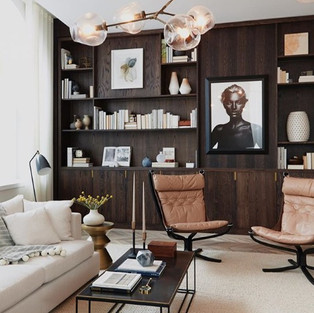NO BUILDER, NO PROBLEM
- Christian Bense
- Mar 13, 2020
- 10 min read
Updated: Aug 23, 2020

One of the questions I get asked most, literally out of all questions people could ask me, is how to add character into a home that doesn't have any to begin with.
It's another one of those "how long is a piece of string" questions, because what defines character? For the sake of UK properties, does character mean period features? Does it mean, I currently have a white house but I'd rather not have a white house? Does it mean quirk? Does character mean having a sense of uniqueness from the flat above or below you?
There are countless approaches to take with this. As this is my blog, and I make the rules, the way I interpret the question "how do I add character?" Is a combination of wanting period features and equal measures of personality and uniqueness. I can't imagine that somebody sitting in a town house in Holland Park is the type of person asking me how to add character to their home, so I imagine those most likely to be asking, either own a new build or have bought a flat from Paul...
*Insert voice over by Lucy Alexander* ...A property developer who, wanting to appeal to a wider and more contemporary market, has ripped out all the features from a 3 storey London terrace and turned it into flats.
As an interior designer who typically works on complete renovation projects, my job is to bring life back into properties, and in doing so adding character. When you have time and money on your side, reinstating or adding in these period features is relatively simple. You tell the builder what you want, and he does it for you.
But what if you have bought, or currently rent, a property from the likes of Paul? Or you simply have no budget/time/energy to rip the guts out of your house to re-add some character? There are some tricks of the trade that can help.
Consider this the "Builder Free Guide To Adding Character To Your Home."
I really want to try and keep this post as free from "conceptual ideas" as possible, and keep the suggestions quite practical and tangible, but in saying that this isn't a DIY blog, so I'll link you to any other fabulous pages or accounts that might be better suited to talking you through the step by step of sanding a floor. I have no shame in admitting that I do not feel comfortable at Home Base.
1) Focal points. In period properties, the majority of the time, the fireplace and chimney breast is the main focal point of the room. Not to say it's in the middle of the room, but the fireplace, as an object, is generally a key player in ensuring the room feels like it has character or some element of interest. Walk into any home that has recently been done up, and comment on the fireplace. I will bet you any amount of money that the owner will start waxing lyrical about it. People love their f**king fireplace.
In a new build or a quick flip developer renno, chances are there ain't no fireplace, and if there is, it’s the remnants of one. Just a flat plastered wall or even worse...a square little hole in the wall. For many, the lack of a fireplace or chimney breast, means that isn't a focal point to a room, something to balance things off, but more importantly there isn't an architectural element injecting any character into the space.
The solution that doesn't involve painting a feature wall? Think big.
Oversized art or a large mirror is a great way to bring focus to a room. It can either detract from the fact that the room is lacking architectural detailing, or it can actually supply the detail the room needs. Now when I say think big, I'm not talking about one A3 frame on the wall. Expecting that to hold up the weight of a boring room, is like expecting a toddler to hold up a car whilst you change a tire. You need to go BIG or at least go plentiful to get this job done. So think an oversized single piece of art, a diverse gallery hang or a whopping mirror, something big, something bold, and something attention grabbing. Granted it's not a log burning flame, but it should ignite something. A conversation at least.
2. Layer it up. Layering is probably the most important step in adding character to a home, and there are numerous ways to achieve this.
Layering, as the name suggests, involves putting one thing in front or on top of something else, in order to create depth or height. It's this creation of depth and height, on or in front of, flat bland surfaces creates interest and helps break up all the clean, straight lines.
Things like art, as I've mentioned before, can do amazing things for a space. Read my post #theposterchild about my thoughts on that.
Rugs is another good one. The is plenty out there showing ideal sizes with various room layouts, so take some time to study those. Slapping a yoga mat under your coffee table isn’t going to do much.
A large rug also helps to zone a space, so if you don’t have any notable features to demarcate a room, a large rug that all your furniture sits on is basically a bulls eye that says “this is the middle.”
Personally the jury is still out on whether or not a vintage or contemporary rug does more or less to add character. I think it's down to the actual weight of the rug. You want something that is on the chunkier side (1cm + ) and is notably different from the colour of the floor.
A lot of what we equate to a rooms character are architectural details. There are loads of ways to add these into a room that doesn’t involve a builder. Adding beading onto plain doors, installing vertical panelling on to flat walls etc etc. All these help in the layering process too.
3. Furniture.
If ever there was going to be a "conceptual idea" this is probably it.
Don't overlook your furniture thinking that the only thing that can give a home character are the floor boards or an elaborate cornice...I have met some pretty dull people in my life whose choice in clothing has been the one redeeming feature about them...same goes for your furniture.
I'm not saying that if you want to add character you have to raid a second hand store and fill your home with antiques, but if you are worried that the four walls of your room are dictating a more contemporary feel than you'd like, opting for a contemporary style sofa is only going to further drive that point home.
I use the example of a sofa, but really I'm referring to the main anchor piece in the room. This could very well be the sofa, but it could also be a chest of drawers, a dining table etc. By picking an anchor piece that has a slightly more traditional shape or vibe to it, is a good way to offset the contemporary lines of the room. Opposite applies when you want to tone down all the theatrics of an overly ornate room...chose something squat and square.
4. Let there be (some) light.
I made a joke in an earlier post, that one way to overcome a boring room is to turn off the lights. Obviously I’m not suggesting that binning your lightbulbs is the way forward to mask a lack of character, but there is some merit in this.
Increasing the variance of your light sources in a room can do wonders to help intensify the mood and help add character. If you only have 6 cool white LED downlights in a room, don’t expect your walls to feel anything other than flat.
Including both table lamps, standing lamps, and even wall lights, shaded and non-shaded, will help to bounce light and cast shadows around the room, and provide light sources for multiple directions, rather than just from above. Obviously if you need the 6 downlights on, turn ‘em on, but if you aren’t performing surgery in your lounge, you don’t need more than a couple of lamps on at a time.
I don’t need to spell it out, but nothing sexy ever happens under a florescent bulb. Lower levels of light adds mood, and if you have no character in a room, or no redeeming features, at least have sexy lighting.
A full blog on lighting coming soon.
5. Don't judge a book.
I went to a Q&A a couple of years ago, with the ever timeless Veere Greeny, and he made a comment about how important books are to a room. Not for any philosophical reason like “books are knowledge and knowledge is life”, but because the uniqueness of books adds diversity to a space.
Nobody can deny the wow factor of walking into a library at the V&A Museum. The architecture aside, I believe that that “wow” comes from the impression that a shed load of books gives.
If you want to add character to a room, exploit the intrinsic “interest factor” of multiple books stacked side by side over a large volume. Don’t spend too much time worrying about what the books are stacked in. An IKEA Kallax bookshelf packed to the brim with books will give a room more character than any of the points mentioned above.
6. On display.
I realise that not everyone might be all that keen on cluttering up every surface of their homes #mariekondo but having things out on display rather than tucked away behind closed doors is a super easy way to add interest to a room.
Obviously we're all down with the idea of using the likes of coffee and console tables as means to display various bits and bobs, but installing open shelving is another great way to help add interest to our 4 walls.
It really just builds on the idea of layering and adding in variance, but it's also a good way to draw attention to where you want it. For example, if you are left with a pigeonhole of a fireplace, amping up the volume on the open shelving alongside, and making the items on display the point of interest, the lack of a fireplace or architectural feature becomes secondary.
It's the same principle as the art, the items on display are there to detract from the lack of architectural detail elsewhere.
7. Avoid white.
Not much more too add than that really. If you want to breathe a bit of life into a space, avoid white.
White is generally perceived as base colour, something lacking, so if a room is painted all white, your eye may read this as the room still needing something…colour.
So take this into consideration if you are starting at 4 white walls and wondering why it all feels a little characterless.
“Avoid white” does not mean “avoid light” however. Something as subtle as SLATE1 will reduce the feeling like a room still needs to be painted.
8. Playing tricks on me.
Sticking with paint, this should really be a first step approach to add character. This isn’t a licence to start painting features walls (these.are.not.ok) but there are a few tricks that can make you think you have details that you really don’t.
Period properties generally have a cornice. As well as projecting across the ceiling, a cornice also projects down the wall a little bit. So typically speaking, your wall colour actually stops short of the ceiling.
If you want to trick your eye into believing that you have a cornice, stop your wall colour about 10cm from the top of the wall, and paint the rest in the same colour as your ceiling.
Not a very high grade trick, and isn’t meant to make anyone think you live in a Buckingham Palace, but it’s a little something something to add to the illusion. Furthermore, being above eye level, it’s a detail that isn’t going to be scrutinised.
I know it might not be for everyone, but this detail works best when the ceilings are actually painted darker than the walls. The darker colours swallow shadows, so if this little detail is in a darker colour, the subtlety in the junction between wall and ceiling is greatly increased.
9. Window treatments
Window treatments aren’t cheap, but dressing your windows is a big tick to adding in a bit of character into a room. This isn’t necessarily to say that that window treatments alone are what add character to an entire room, it’s that window treatments soften the edges, help with the layering, and introduce varied materials. These combined help to add character.
Shutters are a great way to address windows that don’t have an architrave or any sort of decorative profile. The style of shutter chosen can also help amplify a certain style you are trying to achieve. For example, café style shutters can give a space a little bit of a Parisian vibe, where as a shutter with an exposed tilt rod can help things feel a little more traditional.
I’ve done a blog on shutters before, and there are some great resources in there about frame styles etc etc.
A forged iron curtain pole is also a sure-fire way to add in a bit of industrial grit to a space, but is also a good way to make a pair of store-bought curtains feel a little more lux. There is no excuse for a white plastic curtain track or a chunky painted wooden pole.
10. Diversify your portfolio.
Not to just rehash past blog posts, but I wrote one called titled #thesuitespot where I talk about the importance of selecting pieces of furniture that make a space feel curated and collected, rather than all bought off the showroom floor in one whack.
Basically you want to avoid your furniture feeling like it’s part of a suite. If all your fabrics match, all the wood tones are the same, and all pieces are made new, you aren’t doing your house any favours.
Have a look at a serviced apartment in a new build, and you will see how this scenario creates soulless spaces with no character. They are rooms filled with new/trendy pieces, but there is no soul or personality to them or the room they are in.
In addition to varying the source of your furniture, varying finishes is a good thing. You really do need to buy into being a little daring to try and achieve this.
I appreciate that if you don’t have an interior designer on board it’s a little difficult to know which horse to place your bets on, but if you keep some of these ideas in mind, you are safe in knowing that you aren’t exactly going to be breaking bank by attempting to add character.









































